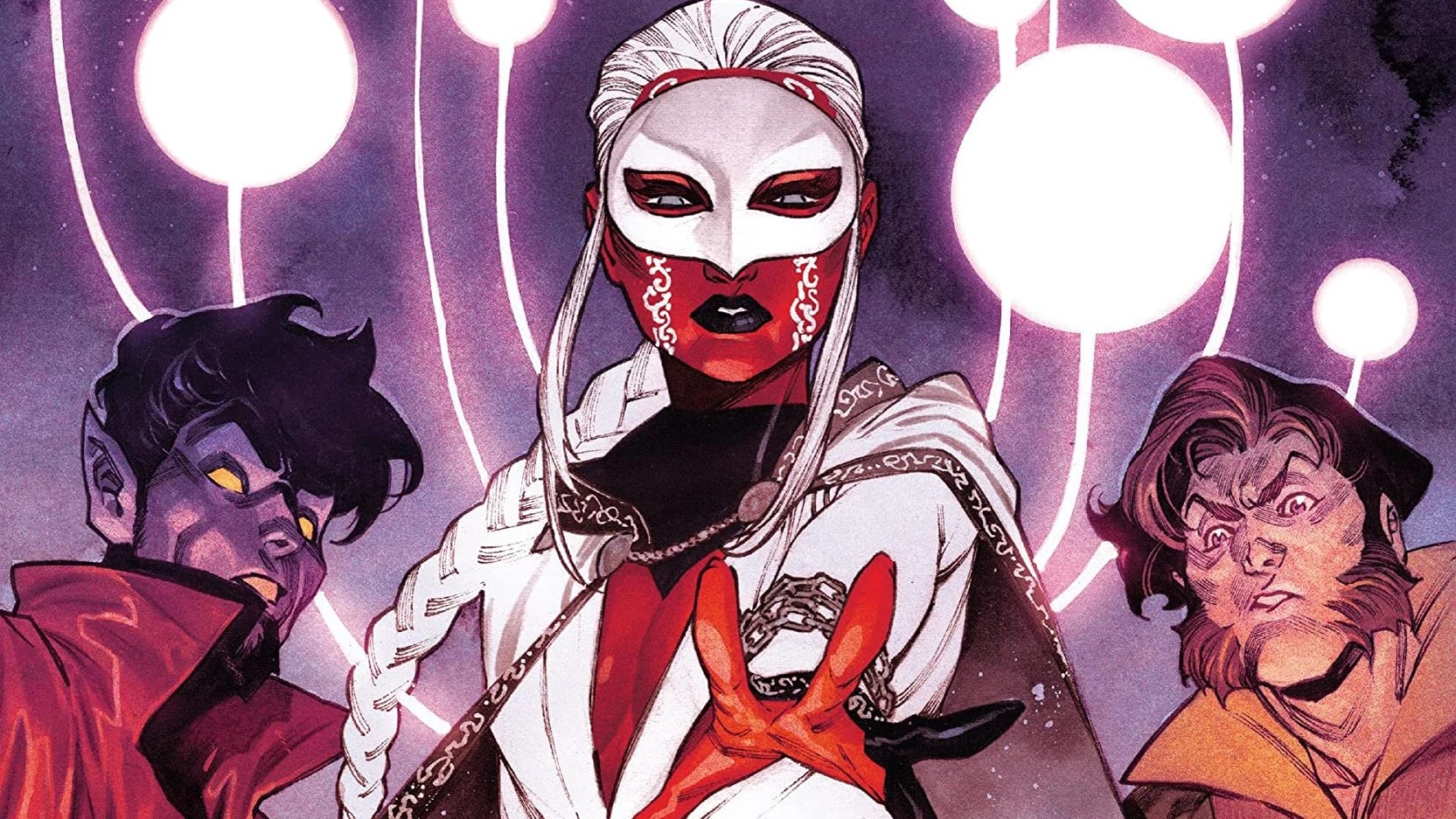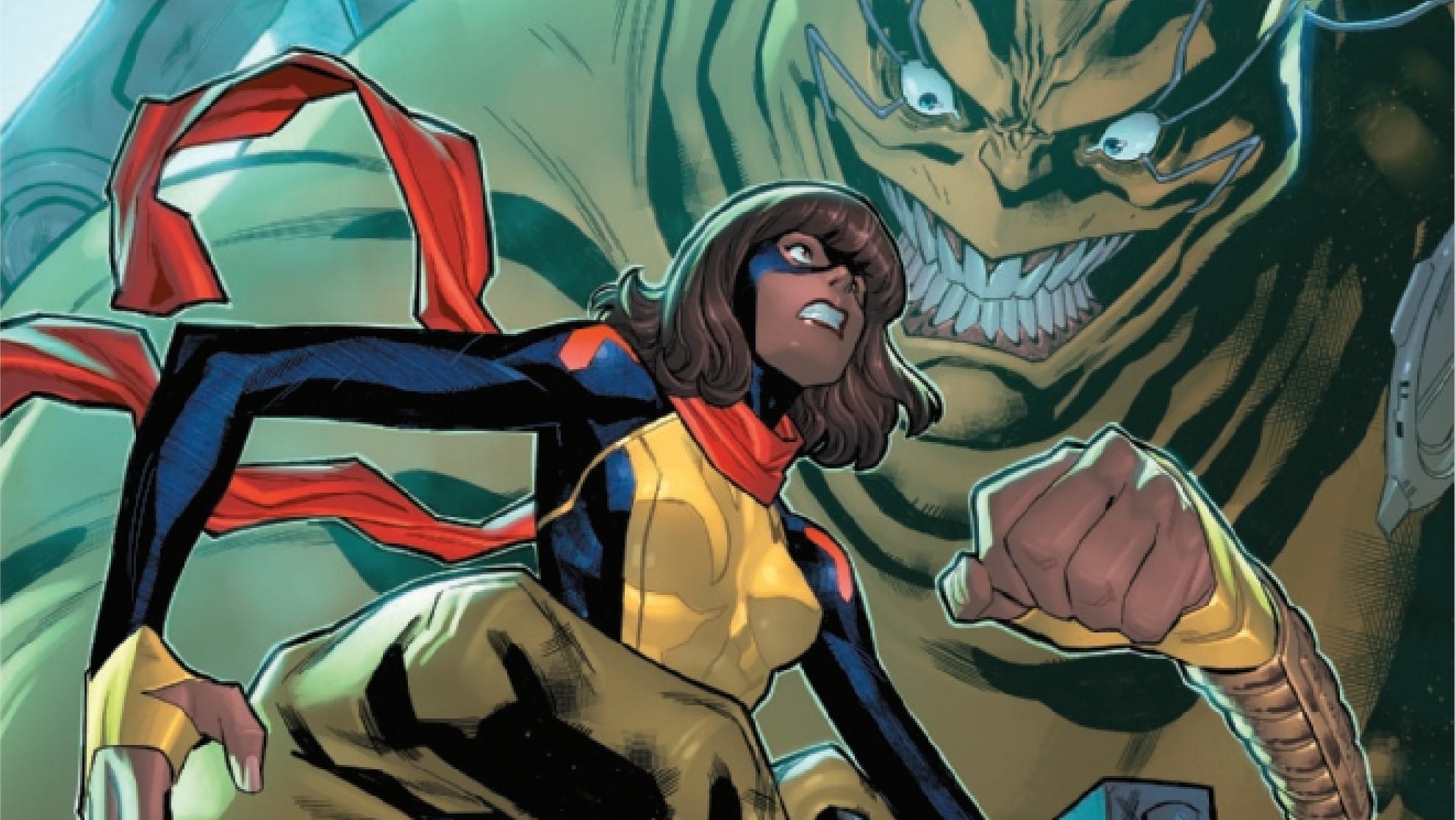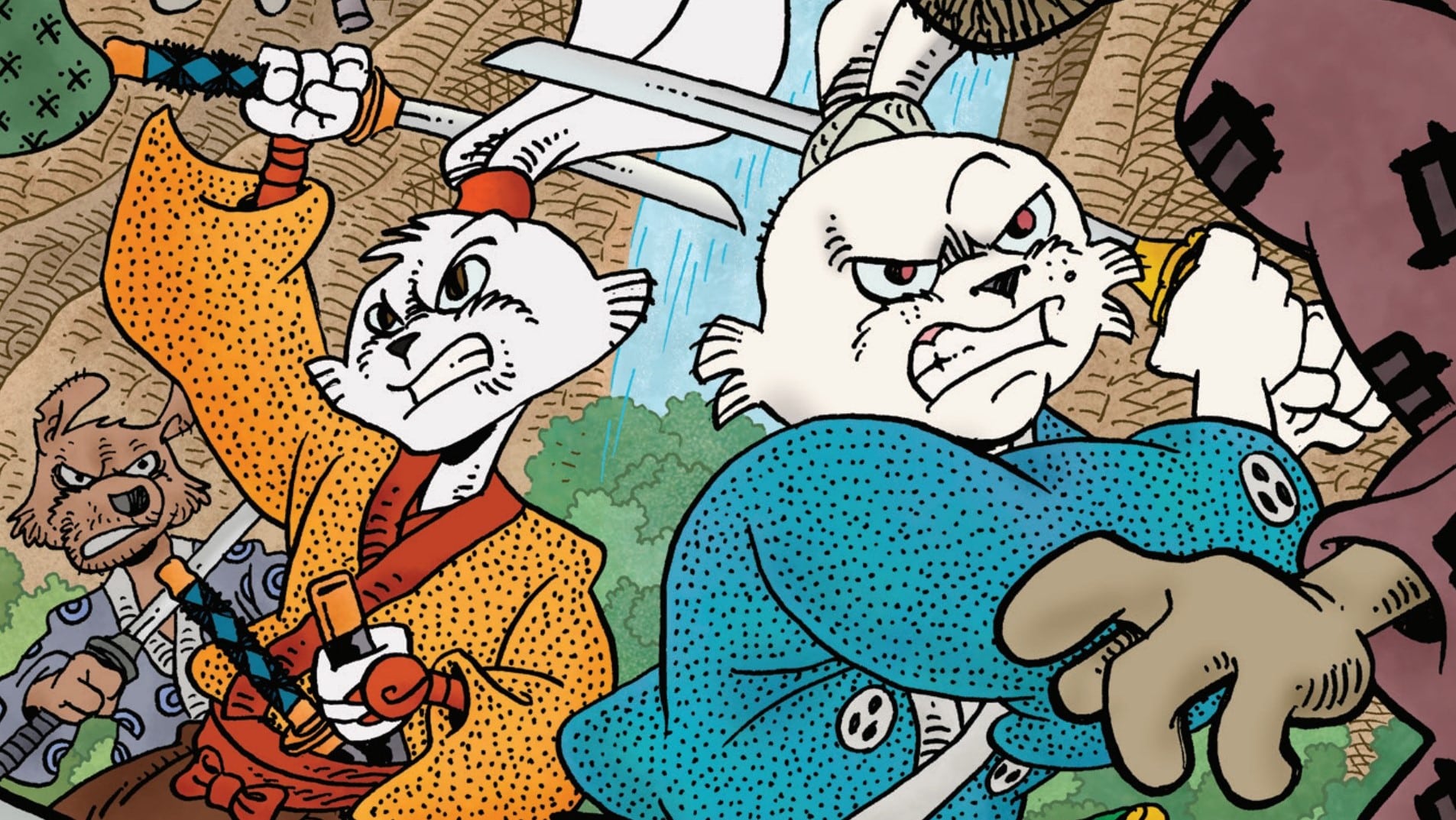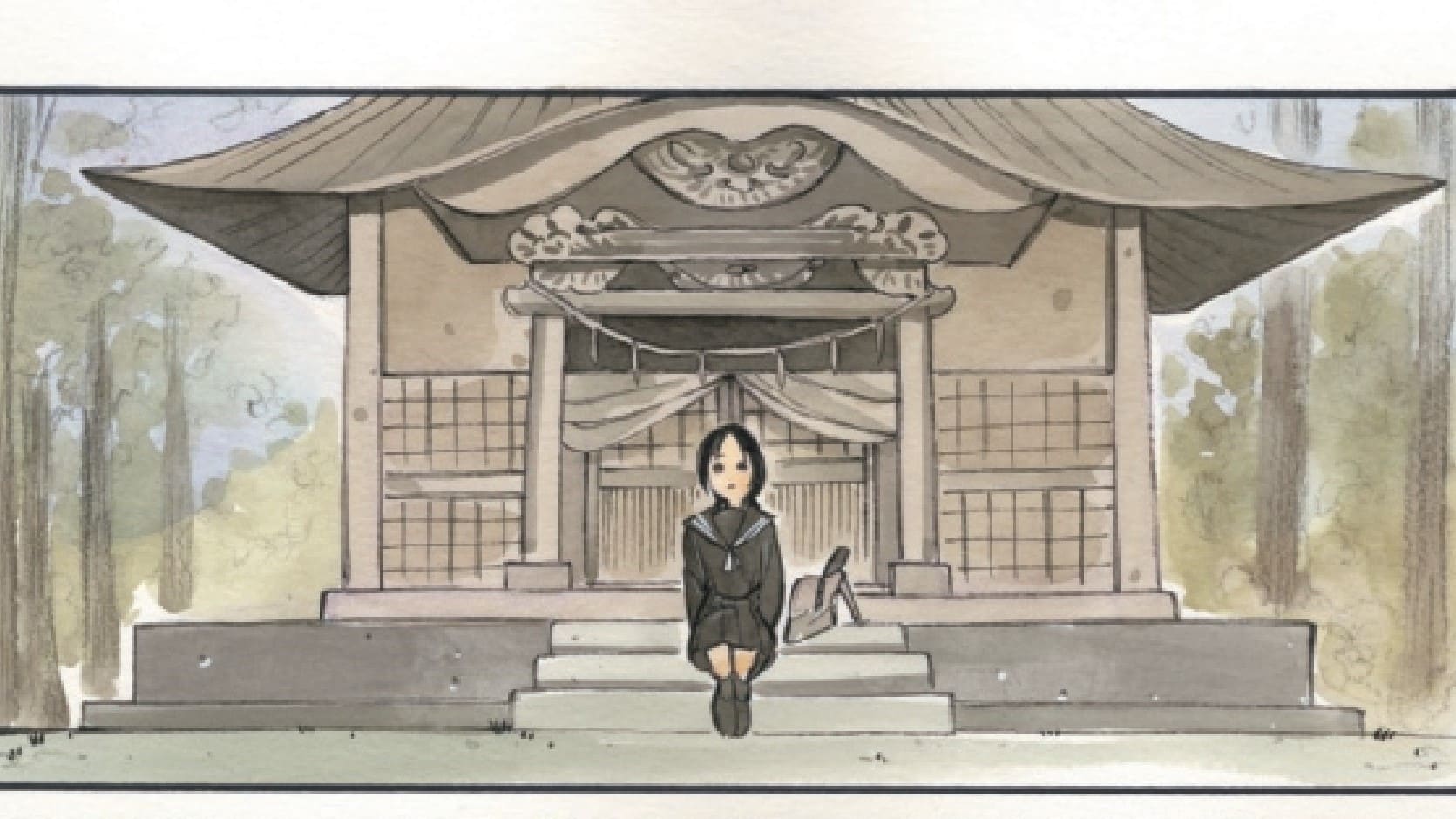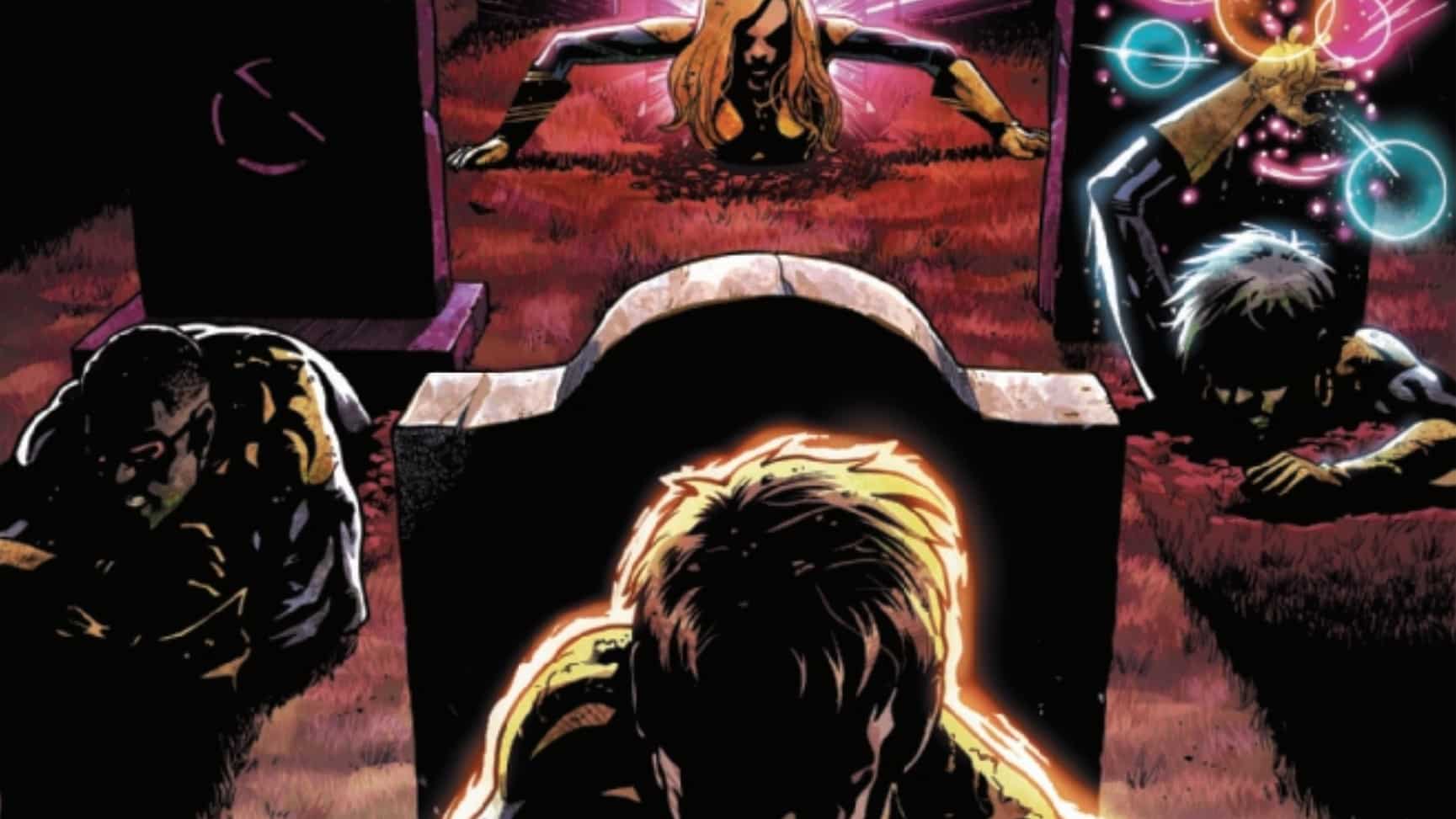The Legionnaires have only just been founded but they have a number of cases on their hands. A skinjacker running amok, a mischievous god on the loose, and Mother Righteous wheeling and dealing her way across Krakoa. Are any of these related? All signs point to yes. Can Nightcrawler and the Legionnaires keep track of everything? All signs point to no. Legion of X #2 is written by Si Spurrier, drawn by Jan Bazaldua, colored by Frederico Blee and lettered by Clayton Cowles.
Armaan Babu: There’s no getting around it, this issue is a mess. There is a lot going on here, crammed into 20 pages, with a lot of concepts thrown at us and not a lot of space to process it all. I’ve been battling a migraine all afternoon and I suddenly suspect this book is at fault!
I, uh, kind of loved it. I don’t agree with everything this issue presents, but damn if it didn’t get my head working in interesting ways. What did you think, Ari?
Ari Bard: I think that a lot of the mess you mentioned can be summed up in a discussion about the layout of the first few pages. We have this discussion between Mother Righteous, Blindfold, and Legion, the contents of which we can get into later, but the visual storytelling is all over the place. There is barely any delineation between Blindfold’s vision, and Legion’s astral plane. There are panels where characters are rotated at strange angles presumably just to fit the lettering. Blee’s colors in this opening scene are some of the most gorgeous I’ve ever seen in a Big Two book, but it doesn’t help readers parse out the chaos here. Then we have a title page crammed with way too much information, likely because the character icons are three times as large as other books, followed by a data page crammed with information in the same visual style. This is probably much less of an issue for those reading a physical copy, but this is a terrible issue opening, especially when reading a digital copy.
Armaan: The chaos has been kind of working for me — especially with the colors working as a callback to the end of X-Men Legacy as David and Blindfold bonded in the Astral Plane. But having more room to space this stuff out would have been great — as it stands, we have a lot to untangle and a limited review space in which to untangle it!
I think.
Wait, do we have word limits here?
Small Gods, Big Trouble

Armaan: I can’t believe I’m bringing up Sir Terry Pratchett two reviews in a row, but have you ever read Small Gods, Ari?
I ask, because this book is starting to feel a lot less like it’s about cops, and a lot more like Small Gods done by way of the X-Men. For those who haven’t read the book, one of its most salient concepts is the idea that human belief is what shapes and powers gods. In the Discworld, where most of Pratchett’s books are set, there a thousands and thousands of little pre-deities just hoping to latch onto a believer, and to have that believer bring in more followers, feeding their god a steady diet of prayers until that desperate little entity is as powerful as one would expect a god to be. It’s an idea that’s been explored in a number of places, but Small Gods seems most relevant here.
The Arrakkii, as we saw last issue, take offense to these would-be gods, desperate for worshippers — but not everyone’s so combative. Mother Righteous appears to be a god in search of a following, and Legion’s her first stop. Considering that Legion’s mind is home to a chunk of Astral Plane that welcomes a pretty large congregation, Legion’s a hell of a get.
Ari: I have not read much of Pratchett’s work, unfortunately, but I am familiar with the concept. It feels like Spurrier read the famous “You have new gods now” line at the beginning or this era and ran with the idea of, “Well, not exactly.” After all, what makes a nation of super-powered mutants different from gods? It must be the extent of their power and where they get their power from. Despite some of my issues with where the page is placed in the issue, Dr. Nemesis’s notes on gods is perhaps one of my favorite data pages. I love the presentation as a control systems block diagram, I love the observational notes, and I love that Spurrier connects it to the rest of the book by posing questions on the data page that extend past the page itself and into the rest of the issue.
I think Mother Righteous may be onto something with Legion in that it may not be just a numbers game. Shouldn’t a certain level of devotion or sacrifice produce more than the faith of your average person? If the acts of a minor god-like being are partially done in service of someone else, that has to be worth a bit more than the standard faith. I imagine this might be the type of thing explored in Small Gods. What really derailed an otherwise fascinating series of concepts for me, was the fact that Mother Righteous co-opted Blindfold, effectively forcing her to have a vision for the sake of persuading David. On a character level, after what happened when David tried to force a connection between two mutants with questionable consent and even more questionable methods, you would think that this would immediately shut him down. On a creative level, you would think that Spurrier would refrain from the idea of forcibly using a woman’s body and or mind without consent for at least a dozen issues. I was not comfortable with how quickly we moved from how those visions were obtained, to the contents of the visions themselves without much consideration for Blindfold’s well-being.
Armaan: On a character level, I can see it working. As much as I want to wholeheartedly like David, there is a part of him that is consistently okay with using other people for his own ends — the idea of consent is something that he forgets about fairly regularly when there’s something else he has his eye on. He’s thrown friends, family and lovers under the bus because he thinks he has a better way of doing things — the question always is, can he be better?
One thing I did enjoy is before Ruth leaves to handle an emergency that Mother Righteous revealed to her, she tells David that his choices are his. David’s used her to try and gain validation for his choices before, but she’s not having it here. David’s choices are his own. “I rule me.”
On a creative level, I’m not sure this was the best choice, but it definitely puts Mother Righteous squarely in the villain category for me. Few gods are to be trusted, but she’s definitely showing her hand pretty early.
Ari: It just feels like a lazy storytelling decision for me. There are better ways to convey to readers that a god is evil and nefarious. There are better ways to convey to readers that Legion’s history is extremely complicated and we can’t consider him to be completely sympathetic no matter how much he’s trying. Things like mind control, forced coercion, skinjacking, and the like can always be used as tools, but the more Spurrier uses them, the less I’m convinced he needs to or that he has anything meaningful to say.
Armaan: I actually feel like it’s a deliberate — if not the most comfortable — choice, given last issue’s statement about what the greatest sin is: treating people like things.
As for Nemesis’ data page about the gods, while I like the numbers idea, there definitely are some flaws with it — which seems in keeping, given how dismissive Nemesis is about magic and gods in the first place, it’s a definite blind spot for the science-obsessed man.
You do bring up a good point — quality should count over quality, sometimes, and Mother Righteous might just be picking her targets with care. Her price for Legion is simple — she just wants a sliver of his gratitude, as much as it may multiply through the Altar, it’s still a sliver. Later, in the issue, though, she sets her sights on Banshee, and given how much she’s aware of how low a place she’s in, I think she’s angling for more than just a sliver of faith there.
What interests me the most is the discussion of some of Marvel’s more established gods, and the idea of Secondary Input. The idea that, at some point, gods carve out enough of a niche out of reality that they can exist without needing followers. Gods like Zeus. Gods like Thor. Gods like…Loki.
When is Loki Not a Loki?

Armaan: Okay, so the Loki teases are so blatant at this point that it’s got to be a misdirect, yeah?
Ari: Given the teases you’ve already mentioned plus the Loki-shaped entity in Ruth’s vision, I wouldn’t be surprised if we saw the figure pop up in this series. Loki and Mother Righteous are certainly compared, and perhaps one or the other is powerful enough to be the demonstrable proof Arakii requires to earn their respect.
The idea of a god craving independence from their congregation is a fascinating one, and the idea that perhaps erasing every record and memory of a god like Thor’s existence makes him physically disappear even moreso.
Armaan: See, I’m really hoping it’s Loki, because similar things have been explored with his character before. Kieron Gillen and Al Ewing wrote Loki as a god shaped by his reputation, and his story, a slight twist on the idea of gods shaped by beliefs. To make a very long story short, Loki killed himself and got reborn as a nicer version of himself just to change the way people saw him. He couldn’t just change like a normal person.
Which is also why I’m hoping why this isn’t Loki, despite the green silhouette of Loki Classic, the God of Mischief reference from last issue, or the Nordic runes showing up around him. Maybe it’s a sliver of an older version of Loki, or maybe it’s Loki proper, rearing his evil head again. It’s still weird to me that the Loki references are this obvious but nobody’s mentioned him yet. He’s even on the cover of the next issue — but it’s Old Loki, so I’m hoping it’s some kind of echo of his former self.
[Ed. note: Me, begging my writers to look at the cover to the next issue]
He’s not the only evil on the island, though. Our Skinjacker, Switch, is pretty vicious. I don’t know a lot about Switch, but he’s about as squarely in the villain category as you can get.
I’ll admit, I was confused at a first read. I thought Loki was the Skinjacker, being called Switch. It speaks to the chaos of the issue that it took me this long to remember that Switch is an entirely separate character — and even then, that’s because you pointed it out to me. I don’t know a lot about Switch, and from some quick research, the internet seems pretty sparse with notes on him as well — he appears to have a very minor role in the Marvel Universe, first appearing waaay back in X-Force #87. We see him possess Banshee to attempt to infiltrate X-Force, to wipe all records of his existence from the island. He has some pretty clear hatred for “primitives” — non-mutants like the Juggernaut — and he definitely gives the Legionnaires a run for their money.
Ari: The Skinjacker being Loki would certainly be a nice way to tie everything going on in the book so far together, but alas, we can only speculate that he’s involved somehow.
Looking at the Skinjacker at face value and ignoring the negative discomfort I feel with Spurrier’s apparent fixation on autonomy of the body and mind, Switch contributes to much of the chaos I feel towards the latter half of the issue. It appears as though he switched back to his own body which is likely buried somewhere on Krakoa from Juggernaut’s description of feeling “cold, dark, and alone.” Everyone jumping and teleporting around along with constantly shifting panel angles really harms the readability of this section.
On top of that, this section comes right after a datapage of Beast insisting that individual harm is not X-Force’s problem in the sense that this Skinjacker committing low-level mischief is not high enough priority so the Legionnaires can handle it. The point is role differentiation and to emphasize that the Legionnaires and the Spark do care about individuals losing their autonomy, but it all lacks nuance when you look at who the mutants losing their autonomy are and how they’re treated. Loa, Mercury, and Blindfold have all been shrugged off in favor of this Skinjacker who is seemingly sticking to powerful men who have probably hardly felt this loss of autonomy before.
I’m only trying to judge what I see on the page, and what I do not see anywhere on the page yet is a hint of a reason for any of this fixation on autonomy. What is the large message Spurrier is trying to send? Why is he continuing to generate a type of conflict he has notoriously had difficulty navigating without really expanding into a large discussion? Instead Spurrier seems to be trying to use the skinjacking as the means to the inevitable end of, “What happens if restorative justice simply doesn’t work?” Switch is portrayed as someone committing evil acts for the fun of it, and it seems like no amount of healing is going to solve the issue, so is it The Pit for him or something else? He hasn’t broken any of the most egregious rules yet has he?
Maybe this would all work better for me if I knew what healing on Krakoa after committing harm did look like, but we don’t get a reasonable conclusion to that either. Every time Legionnaires are talking to Paulie in Legion of X #2, they’re interrupted, and while we get the sense that Paulie wants to be better, and that he wants to feel the guilt, that’s not all there is or needs to be.
Armaan: It’s the biggest problem of too much going on. If this was just a book about gods, we’d have a chance to explore that. This is, ostensibly, a book about restorative justice, and its place in a new community, but we barely have time for all of that. A lot of people are wary about this book, and rightly so, but it feels like we’re being distracted more than reassured that this was a book worth having.
I’m frustrated here because while I’m fascinated with all the god stuff, the question of how the team handles Paulie is the one I want answered most of all, and it’s barely given two pages in this book.
That being said, that one panel of a giant Sooraya hovering over the investigation in that interrogation scene is my favorite of the issue. I’m loving everything Bazaldua and Blee are doing with the Altar, and want more dreamlike stuff like this.
While we don’t get enough of a focus on the Legionnaires’ approach to policing, we do get a pretty big guest appearance from Krakoa’s other big policing force. Or should I have said X-Force?
X-Force vs. Emocops

Armaan: From everything I’ve read of X-Force, they — and Beast, in particular — are some of the very worst of what policing has to offer. Is it just me, or does it feel like Beast was put in this book to soften up the “Emocops”, as Beast puts it, in comparison?
Ari: There is definitely a sense of, “Well, it could be worse,” when it comes to including Beast and Sage in this issue. Even Banshee, a former cop, is at first just another datapoint when it comes to mutant police and different ways to go about it. I will say that it was great seeing Beast get his ass kicked, but it’s not enough to justify including these two members to make your policing team look better while moving Nightcrawler and Weaponless Zsen from place to place.
Armaan: It did look great, though. The quota for action in a superhero comic was well filled in the action scene between Beast and Zsen. Beast may just be the worst person on Krakoa right now, but damn if he doesn’t look good in a fight. A furball of ferocity and the kind of vicious arrogance that makes you cheer for every hit scored against him.
I’ve mentioned my favorite panel, but I think the most hilarious one was Nightcrawler — who, I would remind our readers, is a member of the Quiet Council, Krakoa’s highest governing body — is completely ignorant of the fact that X-Force has been bugging its own people. He even believes with his whole heart that that would never happen, not on Krakoa.
I’m not sure I buy the idea that Nightcrawler is that naive. This issue leans a bit into some Nightcrawler naivete — he is either unaware or tongue-tied in response to women like Sage and Zsen hitting on him. You know, at this point I kind of wish they’d just had another character lead this series — or someone entirely new.
Ari: You say that about Nightcrawler, but he’s also giving Sage a back massage out of nowhere, so I think he has some idea of what he’s doing, even if he has no idea about the obvious mutant surveillance on their own populace. I understand what you mean about another character lead. Right now it seems like Spurrier wants to dive deep into Nightcrawler and Legion and sort of bounce around everyone else on a more surface level. I’d like another character for the book to really explore, but I’m not confident that it has the space to manage something else.
Armaan: Oh, yeah, it definitely needs to disentangle a lot of what’s already going on before it starts introducing new things, but hey, I am happy to have Banshee on the team!
Overall, I’m engaged with what’s going on. I just want some more space to explore it – so I’m majorly grateful to be able to discuss the book here with you, Ari – but I hope that the book slows down soon, and gives its characters the space to shine that they deserve.
Altared Records

- This issue finally gave us the Black Tom/Juggernaut reunion that fans have been waiting for for so long!
- For those interested in knowing more about the craft, the thought process and the origins of Legion of X, Kieron Gillen interviews Si Spurrier here, well worth a listen.
- As a helpful reader pointed out after last issue’s review, Juggernaut’s current armor is not the traditional Cyttorak make, which is probably why Forget-Me-Not’s powers can still affect him.
- Given that Juggernaut was a god’s vassal for most of his career, though, I wonder what his take on gods is.
- Blindfold representing Destiny on the Quiet Council is cool – Legion taking on a Xorn/Zorn-like look when they’re specifically the ones he assigned to keep himself under control is…terrifying.
- We still don’t know what’s happening with Professor X!

